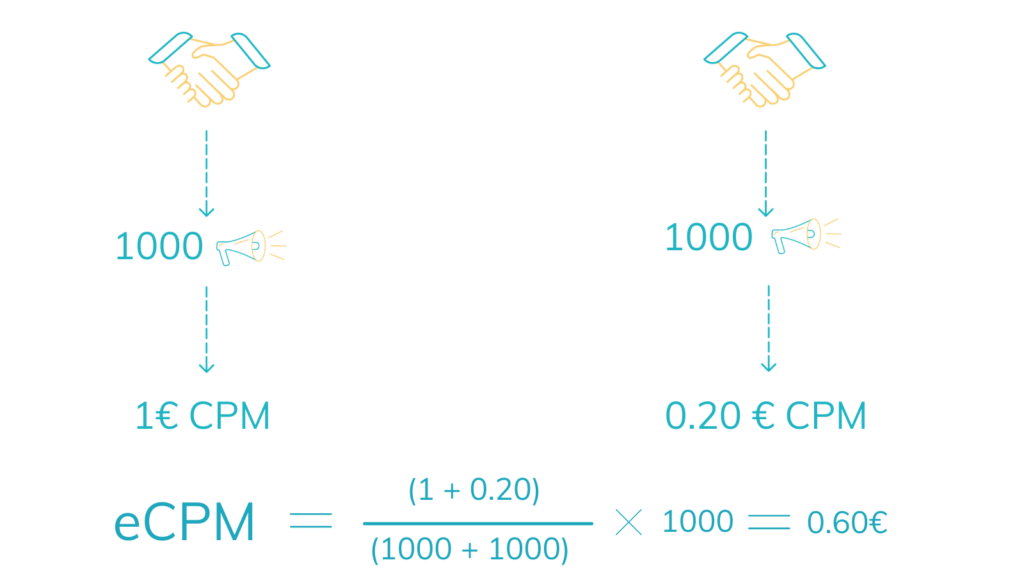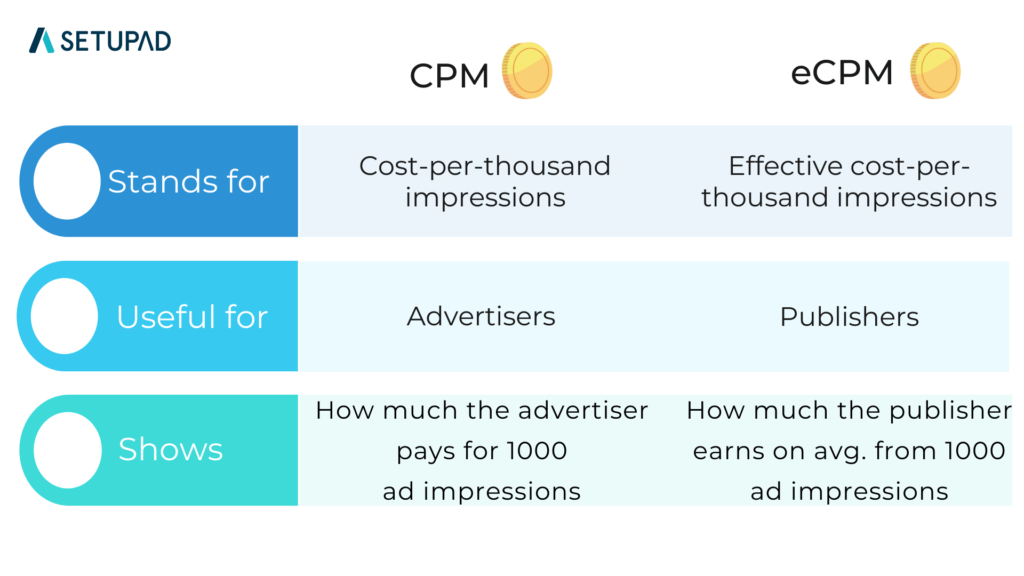eCPM vs CPM | Differences, Formula and How to Calculate?
In digital advertising, two important metrics for publishers and advertisers are CPM and eCPM. This article explores the differences between these two key performance indicators and offers formulas and tips for calculating them to optimize revenue.
What is CPM in Digital Advertising?
CPM stands for cost-per-thousand impressions, or “Cost Per Mille”. It’s a fixed price advertisers bid or pay for each 1000 ad impressions. For publishers, CPM represents the revenue generated from these 1000 ad impressions.
The CPM price is usually high if the website’s traffic is valuable meaning advertisers will be willing to pay more for your ad impressions.
Fixed CPM and CPM Ad Revenue
CPM can either be a fixed rate or vary based on ad demand and auction dynamics. In some cases, publishers may set a fixed CPM, ensuring that advertisers pay a pre-determined rate for each 1000 impressions.
This method can provide more predictable revenue, as publishers know exactly how much they will earn per 1000 impressions. However, it may also limit potential earnings in cases where high demand could lead to higher CPMs if an auction-based model were used.
CPM directly affects ad revenue since it determines how much a publisher will earn from ad impressions sold through the CPM model.
A higher CPM means more revenue for the publisher, but a fixed CPM may miss out on revenue maximization during periods of increased advertiser demand.
CPM Formula
The formula for CPM is the total cost of an ad campaign divided by the number of ad impressions and multiplied by 1000.

How to calculate CPM?
To make the CPM calculation formula more understandable, let’s look at the example.
Let’s imagine that the publisher earned 1000€ by selling 1M ad impressions to a particular advertiser. The calculated CPM would be 1€. This means that the publisher will earn 1€ for every 1000 ad impressions he sells to that advertiser.
(1000€ / 1M) x 1000 = 1€ (CPM)

What is eCPM in Digital Marketing?
eCPM stands for effective cost-per-thousand impressions, or effective “Cost Per Mille”. Both eCPM and CPM illustrate the ad revenue generated by the publisher from 1000 ad impressions.
The main difference is that eCPM is the average of multiple CPMs. Because many advertisers are bidding on each ad impression with different CPMs, the price isn’t fixed.
In programmatic advertising, eCPM becomes a vital metric since it accounts for revenue generated across various pricing models, including CPM, CPC, and CPA.
eCPM gives you the combined average of all advertiser bids for your ad impressions, making it an essential metric for publishers who use diverse monetization models.
Some of your ad inventory can even be purchased via different bidding models, for example, CPC. Therefore, eCPM helps to learn how much you can earn across all bidding models. The higher the eCPM, the higher the total ad revenue for the publisher.
Related Article: How to Increase Ad Revenue | Success Formula and Proven Solutions
What is a Good eCPM?
Many publishers ask, “What is a good eCPM?”
There is no universal answer as it depends on several factors, such as geography, device type, seasonality, and ad format.
Generally, higher eCPMs are seen in regions with higher advertiser demand and during peak advertising seasons, like holidays.
As a benchmark, for desktop traffic in Tier 1 countries, an eCPM of $5-$10 can be considered good, but this varies significantly across industries and traffic types.
eCPM Formula
The formula to calculate eCPM (effective cost per thousand impressions) is:
eCPM = (Total Earnings / Total Impressions) x 1000

How to calculate eCPM?
To calculate eCPM, you need to divide the total earnings by the total number of impressions and then multiply the result by 1000.
The eCPM is a useful metric that helps publishers and advertisers understand the revenue generated per thousand impressions, regardless of the pricing model used (CPM, CPC, CPA, etc.). It’s a valuable metric for optimizing ad performance and comparing ad revenue across different campaigns or ad networks.
Here’s an example. Let’s imagine that there were two campaigns on the publisher’s website.
The CPM for the first campaign was 1€ and the CPM for the second was 0.20€. Each campaign bought 1000 ad impressions.
In this case, the publisher generated total revenue of 1.2€ (1€ + 0.20€) per 2000 (1000 + 1000) ad impressions. Therefore, the eCPM is 0.60€ (1.2€ / 2000 x 1000= 0.60€).

As you may notice, none of the buyers paid a CPM of 0.60€. The eCPM metric helped the publisher to understand the average value of his 2000 ad impressions.
Instead of ad campaigns, different SSPs or ad networks can monetize parts of publishers’ ad inventory with a different rate of eCPM. Whether you call it eCPM or CPM, you need to understand and calculate the average value of your sold inventory.
What is eCPM Floor?
An eCPM floor is the minimum price a publisher is willing to accept for 1000 impressions.
Setting an eCPM floor ensures that the ad inventory is not sold below a certain price, which can be helpful in maintaining higher-quality advertisers and better overall yield.
However, setting a floor price too high could lead to lower fill rates if advertisers are unwilling to meet the minimum price.
What is the Difference Between CPM and eCPM?
The main difference between CPM and eCPM is that CPM shows the advertiser’s cost of 1000 ad impressions, while eCPM shows how much ad revenue the publisher has generated on average from 1000 ad impressions.

CPM vs eCPM: Which Metric Should You Focus On?
For publishers, focusing on eCPM is crucial as it provides an overall picture of the revenue performance of your inventory, accounting for all monetization models, including CPM, CPC, and CPA.
On the other hand, advertisers often focus on CPM to understand the cost of reaching their audience.
If you’re selling high-quality traffic, you may want to focus more on CPM, while eCPM gives you a clearer view of your entire revenue picture.
Let’s look at one more example to better understand the main difference between eCPM and CPM.
Example of eCPM and CPM
Imagine that you have a store that sells kiwis (ad inventory). These kiwis represent ad impressions. Since kiwis can go bad, you want to sell them as fast as possible at the highest price possible.
Let’s say you have 10 kiwis in your storage, and each kiwi represents 1M ad impressions. In total, this gives you 10M ad impressions.
Since your kiwis are the best in your town, you sold the first 5 kiwis (5M ad impressions) almost immediately for the CPM price of 1€. This gave you an ad revenue of 5000€.
(5 000 000 /1 000 x 1€ = 5000€)
Then you sold 4 more kiwis (4M ad impressions) for the CPM of 0.20€, which gave you ad revenue of 800€ (4 000 000 /1 000 x 0.20€ = 800€).
Unfortunately, you couldn’t sell the last kiwi because it went bad.
In total, you sold 9 fresh kiwis and earned 5800€ (5000€ + 800€ = 5800€).
In this case, your eCPM would be your total ad revenue (5800€) divided by the total number of ad impressions you sold (9M), giving you an eCPM of 0.64€.
(5800€ / 9M x 1000 = 0.64€)
❗Bear in mind that eCPM doesn’t represent the 10M ad impressions you initially had in total, but only the 9M you sold.
This means you earned on average 0.64€ for every 1000 ad impressions you sold.

Conclusion
As we learned, high CPMs don’t always equal high ad revenue. Neither do they represent the overall value of your sold ad inventory.
Our examples reveal that publishers should focus on eCPM to monitor their overall ad revenue.
In addition, other metrics, like fill rate and rCPM, are very useful in assessing the overall website monetization performance. Continue to learn about them here. But before that, sign up to start monetizing your website with Setupad!
FAQs about CPM and eCPM
To address common questions that arise when discussing CPM and eCPM, here are a few FAQs:
- What is the best way to calculate eCPM?
The best way to calculate eCPM is by dividing your total earnings by your total ad impressions, then multiplying by 1000. - Is eCPM or CPM better for publishers?
eCPM provides a better overall understanding of how well your ad inventory performs across various campaigns and models, while CPM is more about the fixed cost per 1000 impressions. - What are the advantages of setting a fixed CPM?
Fixed CPM rates offer stability and predictability for publishers, but you might miss opportunities to earn more when demand is high.


